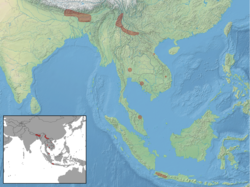| Bronze sprite | |
|---|---|
 | |
| Scientific classification | |
| Kingdom: | Animalia |
| Phylum: | Chordata |
| Class: | Mammalia |
| Order: | Chiroptera |
| Family: | Vespertilionidae |
| Genus: | Arielulus |
| Species: | A. circumdatus |
| Binomial name | |
| Arielulus circumdatus (Temminck, 1840) | |
 | |
| Synonyms | |
| |
The bronze sprite (Arielulus circumdatus), [2] also known as the black-gilded pipistrelle, is a species of vesper bat found in China, India, Myanmar, and Nepal.
